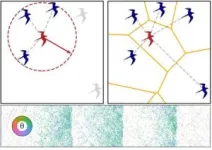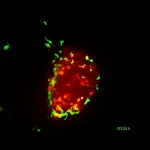(Press-News.org)
Climate change is one of the most significant environmental challenges of present times, leading to extreme weather events, including droughts, forest fires, and floods. The primary driver for climate change is the release of greenhouse gases into the atmosphere due to human activities, which trap heat and raise Earth’s temperature. Aerosols (such as particulate matter, PM2.5) not only affect public health but also influence the Earth's climate by absorbing and scattering sunlight and altering cloud properties. Although future climate change predictions are being reported, it is possible that the impacts of climate change could be more severe than predicted. Therefore, it is necessary to detect climate change accurately and as early as possible.
Building on these insights, a research team from Japan, led by Professor Hitoshi Irie from the Center for Environmental Remote Sensing at Chiba University, utilized long-term observational data to study the effect of climate change on transboundary air pollution in the downwind area of China by using aerosols. They utilized a completely unique perspective on how aerosols impact climate and developed a new metric to detect climate change by considering aerosols as tracers.
“The significance of this study lies in the fact that most of its results are derived from observational data. In natural sciences focused on Earth studies, the ultimate goal is to piece together highly accurate data obtained from observations to quantitatively understand the processes occurring on Earth and to pursue immutable truths. Therefore, the more observational data we have, the better. With the continued Earth observations by Japan's major Earth observation satellites (such as the GCOM series, GOSAT series, Himawari series, and ALOS series), we aim to complement these efforts with numerical simulations and data science methodologies to achieve a safe and secure global environment that mitigates the impacts of the climate crisis.” explains Prof. Irie.
The research team included Ms. Ying Cai from the Graduate School of Science and Engineering, Chiba University, Dr. Alessandro Damiani from the Center for Climate Change Adaptation, National Institute for Environmental Studies, Dr. Syuichi Itahashi and Professor Toshihiko Takemura from the Research Institute for Applied Mechanics, Kyushu University, and Dr. Pradeep Khatri from Faculty of Science and Engineering, Soka University. Their study was made available online on May 23, 2024, and published in Science of The Total Environment on August 20, 2024.
China is a major contributor to air pollution in East Asia. The downwind area of China analyzed in this study is a unique open ocean area with minimal human interference yet an important zone of transboundary air pollution pathways, making it an ideal location for studying meteorological variations due to climate change.
In their study, the researchers analyzed aerosol optical depth (AOD) datasets derived from satellites, reanalysis datasets, and numerical simulations focused on the Pacific Ocean in the downwind area of China, over 19 years from 2003 to 2021. AOD, a measure of the amount of sunlight blocked by aerosols, is a key factor is analyzing aerosols and their impact on climate change.
The researchers developed a new metric called RAOD which utilized the potential of aerosols as tracers to evaluate the impact of climate change on transboundary air pollution pathways. Using RAOD the researchers were able to quantify significant temporal variations in aerosol transport. They discovered that long-term changes in RAOD due to climate change were outweighed by larger year-to-year variations in the meteorological field. Moreover, seasonal trends showed that aerosols moved west to east during spring and winter, and northward in summer. They concluded that the probability of aerosols from China to be transported far eastward was low, highlighting a shift in transboundary pollution pathways due to global warming. In this study the authors successfully detected climate change using long-term satellite observational data, in contrast to most existing studies that tracked transboundary air pollution using model simulations.
“These results suggest that RAOD is a valuable metric for quantifying the long-term changes in transboundary air pollution pathways due to climate change. These results are particularly significant because most of them are derived from observational data,” says Prof. Irie, highlighting the importance of the study. Sharing the future implications of their study he concludes, “The effects of climate change could be more severe than currently predicted. This study will help verify climate change predictions from an unconventional perspective of ‘aerosol observation,’ enabling a more accurate understanding of climate change progression and implementation of rational countermeasures.”
In summary, this study demonstrates an innovative use of aerosols as climate change tracers, marking a significant step forward in the global effort to tackle the pressing issue of climate change.
About Professor Hitoshi Irie
Hitoshi Irie is currently a Professor at the Center for Environmental Remote Sensing (CEReS) at Chiba University. He obtained his M.S. and Ph.D. degrees from Nagoya University, Japan in 1999 and 2002, respectively. He has over 230 publications with over 6400 citations. At Chiba University, he also leads the Irie lab, which focuses on studying the effects of climate change. His research focuses on understanding the evolution of air pollution and climate change on a global scale.
END
According to the attention-based view, a firm’s actions and growth performance are directly influenced by its attentional allocation to specific issues. The consequences of organizational attention are reflected in the firm’s strategic decision-making and adaptability. However, existing literature is limited in its exploration of how a firm’s attentional uniqueness impacts its behavior and performance. Notably, attentional uniqueness refers to how the firm’s attentional allocation diverges from competitors in the same industry.
To address the above-mentioned knowledge gap, Associate Professor Takumi ...
The deoxyribonucleic acid or DNA, the molecular system that carries the genetic information of living organisms, can transcribe and amplify information using its two helical strands. Creating such artificial molecular systems that match or surpass DNA in functionality is of great interest to scientists. Double-helical foldamers are one such molecular system.
Helical foldamers are a class of artificial molecules that fold into well-defined helical structures like helices found in proteins and nucleic acids. They have garnered considerable attention as stimuli-responsive switchable molecules, tuneable chiral materials, and cooperative supramolecular systems due to their chiral and ...
A saliva test can more accurately indicate the severity of recurrent respiratory infections in children than the standard blood test. If saliva contains too few broadly protective antibodies, a child is more likely to suffer from pneumonia episodes. This is reported by researchers from Radboudumc Amalia Children's Hospital and UMC Utrecht Wilhelmina Children's Hospital in the European Respiratory Journal. Saliva testing provides valuable information for treatment and is more comfortable for children.
About ...
Research Highlights:
Researchers found repeated one-minute bursts of high-intensity interval training were more effective than traditional, moderate continuous exercise for improving the body’s aerobic fitness after a stroke.
Fitness level improvements doubled in participants in the high-intensity interval training group compared to those in the moderate intensity exercise group.
Researchers found the level of fitness changes in the high intensity interval training group were associated with improved survival and lower risk of stroke-related ...
Pathological abnormalities associated with motor neurone disease have been identified using a new technique developed at the University of Birmingham.
The method will help scientists better understand the changes in the brain that lead to motor neurone disease (MND) and could eventually yield insights that will help with the development of new treatments. The abnormalities were identified in a collaboration between the University of Birmingham and the University of Sheffield and published today [8 Aug] in Nature Communications.
Motor neurone disease, also known ...
Using zebrafish “Avatars”, an animal model developed by the Cancer Development and Innate Immune Evasion lab at the Champalimaud Foundation (CF), led by Rita Fior, Mayra Martínez-López – a former PhD student at the lab now working at the Universidad de las Américas in Quito, Ecuador – and colleagues studied the initial steps of the Bacillus Calmette-Guérin (BCG) vaccine’s action on bladder cancer cells. Their results, which are published today (August 1, 2024) in the journal Disease Models and Mechanisms, show that macrophages – the first line of ...
August 8, 2024, Cleveland: New Cleveland Clinic research shows that consuming foods with erythritol, a popular artificial sweetener, increases risk of cardiovascular events such as heart attack and stroke. The findings, from a new intervention study in healthy volunteers, show erythritol made platelets (a type of blood cell) more active, which can raise the risk of blood clots. Sugar (glucose) did not have this effect.
Published in Arteriosclerosis, Thrombosis and Vascular Biology, the research adds to increasing evidence that erythritol may not be as safe as currently ...
Scientists have developed a new way of counting labelled proteins in living cells that could become a standard and valuable tool in the field of biomedical research.
This powerful new technique, known as Protein-tag Degree of Labelling (ProDOL), provides a robust and versatile approach for precisely determining labelling efficiencies, the number of proteins that are labelled with fluorescent markers in living cells, in microscopy, a crucial aspect of protein quantification in biological research.
The method ...
Since the industrial revolution, microbes have successfully colonized one novel type of habitat after another: for example marine oil spills, plastic floating in the oceans, industrial brownfields, and even the interior of the International Space Station.
However, it turns out that one extreme environment harboring a specialized community of highly adapted microbes is much closer to home: inside microwaves. This finding has now been reported for the first time in a study in Frontiers in Microbiology by researchers from Spain. It’s not only important from the perspective of ...
The Institute of Science and Technology Austria (ISTA) today announced it is investing in a state-of-the-art cluster of over 100 NVIDIA H100 Tensor Core GPUs to enhance its computing infrastructure and scale up machine learning for academic research. The latest-generation GPU cluster specializes in training large language models for generative AI and machine learning. The Institute-funded, multi-million investment helps accelerate AI research in the public sphere at scale and consolidates ISTA as a European computational hotspot.
In the generative artificial intelligence (AI) era, AI research and ...








